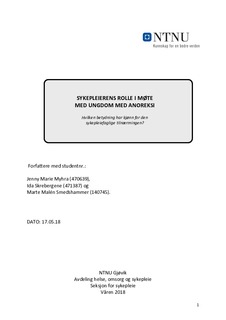| dc.contributor.advisor | Struksnes, Solveig | |
| dc.contributor.author | Myhra, Jenny Marie | |
| dc.contributor.author | Skrebergene, Ida | |
| dc.contributor.author | Smedshammer, Marte Malén | |
| dc.date.accessioned | 2018-08-27T08:29:58Z | |
| dc.date.available | 2018-08-27T08:29:58Z | |
| dc.date.issued | 2018 | |
| dc.identifier.uri | http://hdl.handle.net/11250/2559386 | |
| dc.description.abstract | Innledning: Hensikten med studien er å tilegne seg kunnskaper om hvordan sykepleiere kan skape en terapeutisk relasjon til ungdommer med anoreksi. Forfatterne ønsket å finne ut hvordan sykepleier kan bruke seg selv terapeutisk til tross for forskjellene mellom jenter og gutter med anoreksi. Bakgrunn: Spiseforstyrrelser er et spennende og omdiskutert tema. Gutter oppleves som en minoritetsgruppe når det kommer til anoreksi, som er understudert. Dette vekket forfatternes interesse til å se nærmere på grunner til dette og hvilke ulikheter og likheter det finnes mellom kjønnene. Videre ble det fokusert på viktigheten av terapeutisk relasjon i behandling. Metode: Metoden i denne studien er en litteraturstudie. Det ble gjort et systematisk litteratursøk etter vitenskapelige forskningsartikler som skulle svare på oppgavens problemstilling. Forfatterne endte tilslutt opp med fem artikler. Resultat: Basert på funnene i artiklene som ble brukt, endte forfatterne opp med to hovedtemaer, med aktuelle undertema. Hovedtemaene var å forstå fenomenet anoreksi og hvordan sykepleier kan bygge en terapeutisk relasjon til ungdom med anoreksi. Dette ble videre drøftet opp mot aktuell litteratur. Konklusjon: Det ligger ikke til grunn for at jenter og gutter skal behandles ulikt, men hvert enkelt individ kan ha ulike ønsker og behov som sykepleiere må ta hensyn til. Videre er det konkludert at samtalen og den terapeutiske relasjonen er et viktig redskap for et godt behandlingsresultat. Det er viktig at sykepleiere innehar forståelse og kunnskap av lidelsen for å kunne skape en terapeutisk relasjon. | nb_NO |
| dc.description.abstract | Introduction: The purpose of the study is to acquire knowledge of how nurses can create a therapeutic relationship with young people with anorexia. The authors wanted to find out how nurses can use themselves therapeutically despite the differences between girls and boys with anorexia. Background: Eating disorder is an exciting and controversial topic. Boys are experienced as a minority group when it comes to anorexia, which is undergraduate. This awakened the authors' interest in looking into the reasons for this and what inequalities and similarities existed between the sexes. Furthermore, it was focused on the importance of therapeutic relationship in treatment. Method: The method of this study is a literature study. A systematic literature search was conducted to find scientific research articles that would answer the topic question. The authors ended up with five articles. Result: Based on the findings in the articles that were used, the authors ended up with two main themes, with current subtitles. The main themes were to understand the phenomenon of anorexia and how the nurse can build a therapeutic relationship with young people with anorexia. The articles were further discussed with each other and relevant literature. Conclusion: There is no reason why girls and boys should be treated differently, but each individual may have different wishes and needs that nurses need to take into account. Furthermore, it has been concluded that the conversation and therapeutic relationship are an important tool for a good treatment outcome. It is important that nurses hold the understanding and knowledge of the disorder to create a therapeutic relationship. | nb_NO |
| dc.language.iso | nob | nb_NO |
| dc.subject | sykepleie | nb_NO |
| dc.subject | anoreksi | nb_NO |
| dc.subject | terapeutsik relasjon | nb_NO |
| dc.title | Sykepleiers rolle i møte med ungdom med anoreksi | nb_NO |
| dc.title.alternative | Nurses role in meeting adolescents with anorexia | nb_NO |
| dc.type | Bachelor thesis | nb_NO |
| dc.subject.nsi | VDP::Medical disciplines: 700::Health sciences: 800::Nursing science: 808 | nb_NO |
| dc.source.pagenumber | 44 | nb_NO |
